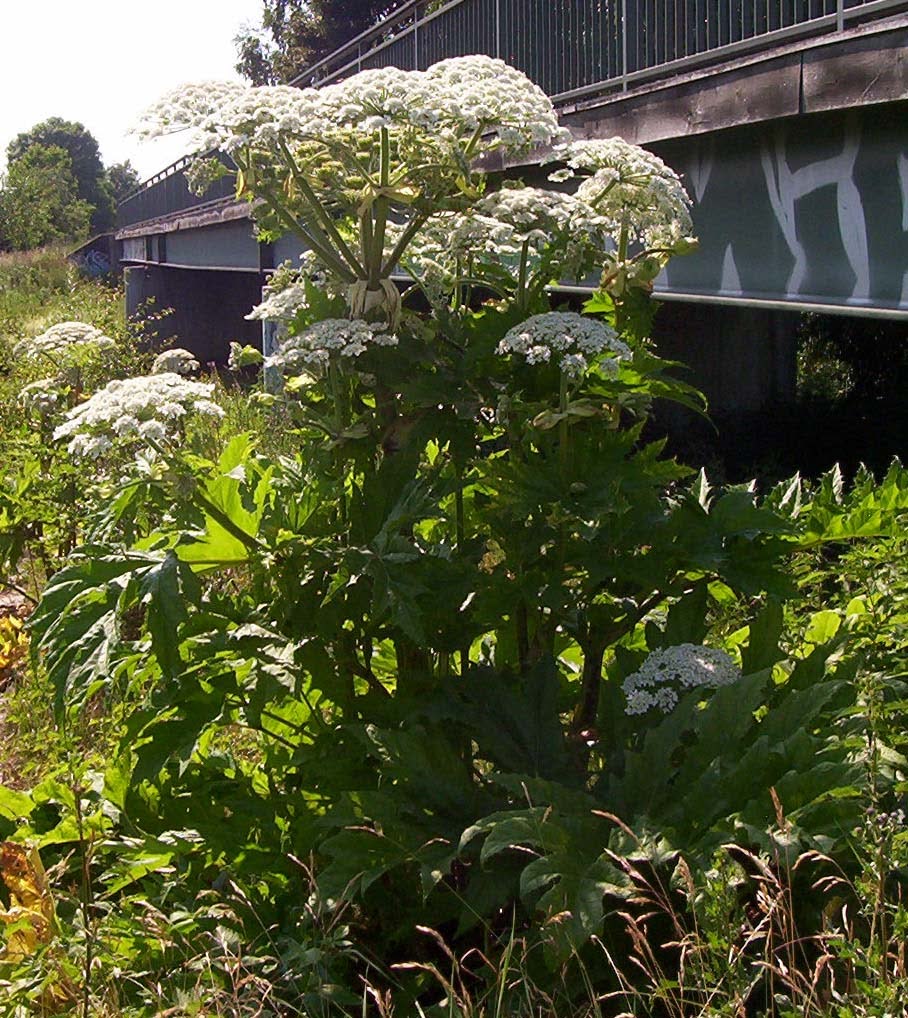Blame it on the bike ride
The correct answer is E. The patient had unknowingly come into contact with Heracleum mantegazzianum, a highly phototoxic plant. Diagnosis in such cases relies on clinical pattern and history. Linear bullous lesions, delayed onset after sun exposure, and the absence of systemic symptoms help narrow the differential diagnosis:
- A: irritant contact dermatitis is typically pruritic, well-demarcated, and localized;
- B: chemical burns generally have immediate onset and a history of known contact;
- C: herpes zoster presents with dermatomal distribution and neuropathic pain;
- D: autoimmune bullous diseases are rare at this age and show slower, symmetric progression.
The diagnosis was confirmed after discovering that Heracleum mantegazzianum was present along the bike path where the patient had fallen days before symptom onset.
Heracleum mantegazzianum (credit: Wikipedia, photographer: Appaloosal)
A dangerous plant
Heracleum mantegazzianum, known as giant hogweed, is an invasive herbaceous plant native to the Caucasus, now widespread in Central and Northern Europe. Initially introduced for ornamental purposes in the 19th century, it is now classified as a harmful invasive species. Its sap contains furanocoumarins, which become phototoxic when exposed to UV light. Reactions range from painful blistering burns to more severe complications, including transient neurological symptoms in affected areas.
The plant poses a public health risk due to:
- its presence in peri-urban areas (bike paths, parks, roadsides);
- persistent phototoxic sap on skin, clothing, and objects;
- low public awareness and difficulty identifying the plant.
A German mapping study identified over 1300 established H. mantegazzianum populations in public and peri-urban environmental. The risk increases in summer, particularly for outdoor workers and people managing vegetation.
Several EU countries have implemented containment programs and public awareness campaigns. The plant is listed in the EU Regulation 1143/2014 on invasive alien species, and removal is mandatory in public spaces in some regions.
Severe burn cases requiring surgical intervention are reported in the literature, particularly in pediatric patients or after intense unprotected exposure. Awareness and prevention are essential - long clothing, immediate washing, and sun avoidance are critical preventive steps, even in non-agricultural occupational settings.
Practical tips for clinicians
During summer, the risk of accidental contact with Heracleum mantegazzianum increases, especially in neglected green areas, riverbanks, trails, and roadsides. Clinicians should:
- Include environmental history (outdoor work, falls, hikes) in the evaluation of unexplained bullous lesions;
- Educate patients on plant identification: up to 3 meters tall, purple-mottled stems, large lobed leaves, and wide white umbrella-shaped flower clusters (up to 80 cm diameter);
- Remember that the sap remains active for hours on contaminated skin, clothing, or objects, even without immediate sunlight exposure.
- Klimaszyk P, et al. Unusual complications after occupational exposure to giant hogweed. Int J Occup Med Environ Health. 2014;27(1):141–144. doi:10.2478/s13382-014-0238-z
- Chan JCY, Sullivan PJ, O’Sullivan MJ, Eadie PA. Full thickness burn caused by exposure to giant hogweed: Delayed presentation, histological features and surgical management. J Plast Reconstr Aesthet Surg.2011;64(1):128–130. doi:10.1016/j.bjps.2010.03.030
- Nielsen C, Ravn HP, Nentwig W, Wade M (Eds.). The Giant Hogweed Best Practice Manual. Forest and Landscape Denmark, 2005.
